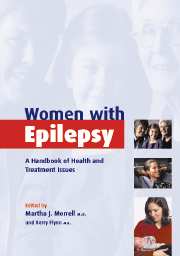Book contents
- Frontmatter
- Contents
- List of contributors
- Part I The woman with epilepsy
- Part II Epilepsy diagnosis and treatment
- Part III Hormones and the brain
- Part IV Health challenges for women with epilepsy
- Part V Family planning, pregnancy, and parenting
- 18 Family planning and contraceptive choice
- 19 Pregnancy risks for the woman with epilepsy
- 20 Risks of birth defects in children born to mothers with epilepsy
- 21 Neurocognitive outcome in children of mothers with epilepsy
- 22 Parenting for women with epilepsy
- Part VI Living well with epilepsy
- Appendix: The Epilepsy Foundation's Campaign for Women's Health: bringing help and hope to women with epilepsy
- Index
- References
19 - Pregnancy risks for the woman with epilepsy
from Part V - Family planning, pregnancy, and parenting
Published online by Cambridge University Press: 02 November 2009
- Frontmatter
- Contents
- List of contributors
- Part I The woman with epilepsy
- Part II Epilepsy diagnosis and treatment
- Part III Hormones and the brain
- Part IV Health challenges for women with epilepsy
- Part V Family planning, pregnancy, and parenting
- 18 Family planning and contraceptive choice
- 19 Pregnancy risks for the woman with epilepsy
- 20 Risks of birth defects in children born to mothers with epilepsy
- 21 Neurocognitive outcome in children of mothers with epilepsy
- 22 Parenting for women with epilepsy
- Part VI Living well with epilepsy
- Appendix: The Epilepsy Foundation's Campaign for Women's Health: bringing help and hope to women with epilepsy
- Index
- References
Summary
Making the decision to have a child can be joyous, as well as frightening. Every parent hopes that the pregnancy will be uncomplicated and the child will be born healthy. Women with epilepsy may be especially concerned that the risk of pregnancy complications and birth defects could be higher because of seizures and because the baby will be exposed to antiepileptic drugs. However, many women with epilepsy (and their physicians) believe these risks to be higher than they really are. Therefore, it is especially important for women with epilepsy to have access to comprehensive and accurate information in order to make an informed and appropriate choice. In addition, strategies to optimize seizure control, minimize medication exposure, and provide essential preconceptional vitamin supplementation need to be in place before pregnancy occurs. The information contained in the next two chapters should provide a good basis for discussion among women with epilepsy, their neurologists and obstetricians/ gynecologists.
Dr Mark Yerby is a faculty member at the University of Oregon and an epilepsy expert who lectures widely on this topic. Dr El-Sayed, who provides the information contained in the boxes in Chapters 19 and 20, is an Assistant Professor in Obstetrics and Gynecology at Stanford University. He has special expertise in the gynecological and obstetrical care of women with epilepsy.
MJMReproductive health care is important for every woman. For a woman with epilepsy, regular appointments with her neurologist do not replace the essential visits to her obstetrician/gynecologist.
Keywords
- Type
- Chapter
- Information
- Women with EpilepsyA Handbook of Health and Treatment Issues, pp. 203 - 214Publisher: Cambridge University PressPrint publication year: 2003
References
- 2
- Cited by



